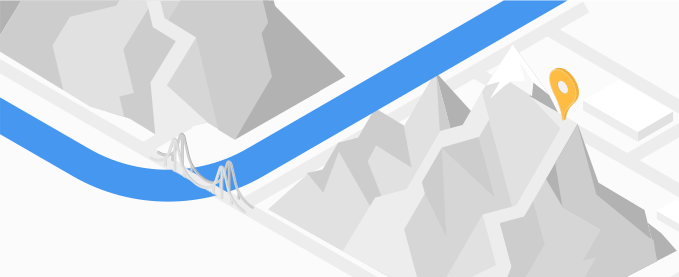
Elevation API คือบริการที่แสดงผลข้อมูลระดับความสูงสําหรับ ตำแหน่งบนพื้นโลก หรือข้อมูลการยกตัวอย่างจากเส้นทาง
เหตุผลที่ควรใช้ Elevation API
เมื่อใช้ Elevation API คุณสามารถพัฒนาแอปพลิเคชันเพื่อสนับสนุน ลูกค้าที่มีกิจกรรมที่ไวต่อระดับความสูง แอปพลิเคชันระบุตำแหน่ง หรือการสำรวจระดับต่ำ แอปพลิเคชันที่รวมการยกระดับและการเปลี่ยนแปลงระดับความสูงตลอดเส้นทาง ตัวอย่างเช่น คุณสามารถให้ข้อมูลความสูงสะสมและการสูญเสียเพื่อปรับปรุงแอปพลิเคชันกีฬาสำหรับกิจกรรมต่างๆ เช่น เช่น เดินเขา ปั่นจักรยาน หรือดำน้ำลึก
สิ่งที่คุณทำได้ด้วย Elevation API
ด้วย API ระดับความสูง คุณสามารถรวมข้อมูลระดับความสูงไว้ใน แอปพลิเคชัน หรือบนแผนที่ เช่น
- ดูระดับความสูงของสถานที่ที่เจาะจง
- คำนวณความแตกต่างของระดับความสูงตามเส้นทางหรือระหว่าง 2 คะแนน
วิธีการทำงานของ Elevation API
Elevation API จะยอมรับคำขอเป็น URL ที่เข้ารหัสโดยมีพิกัดละติจูด/ลองจิจูด แสดงเป็นสถานที่ที่แยกจากกัน หรือเป็นชุดตำแหน่งตลอดเส้นทาง คำขอนี้ ตัวอย่างเช่น ระดับความสูงของการค้นหาสำหรับใจกลางเมืองเดนเวอร์ รัฐโคโลราโด ที่ระบุการแสดงผลในรูปแบบ JSONhttps://maps.googleapis.com/maps/api/elevation/json ?locations=39.7391536%2C-104.9847034 &key=YOUR_API_KEY
บริการรับรู้ระดับความสูงสำหรับพิกัดที่ระบุ และยังช่วยประมาณค่า ระดับความสูงสำหรับสถานที่ตั้งที่ไม่มีระดับความสูง ซึ่งแสดงค่าเฉลี่ยที่ส่งคืนจากสี่ สถานที่ใกล้เคียงที่สุดที่ให้ข้อมูลระดับความสูง สุดท้าย โมเดลจะตัดสิน ความละเอียดของสถานที่นั้น
แหล่งข้อมูล
ตารางต่อไปนี้สรุปแหล่งข้อมูลที่มีให้ผ่าน Elevation API และข้อมูลที่ส่งกลับมา
| แหล่งข้อมูล | ข้อมูลที่ส่งคืน | รูปแบบการคืนสินค้า |
|---|---|---|
| พิกัดละติจูด/ลองจิจูด
คุณสามารถให้ข้อมูลเป็นชุดของตำแหน่งอย่างน้อย 1 แห่ง หรือเป็นชุดตามเส้นทางก็ได้ คุณ ก็สามารถให้พิกัดที่เข้ารหัสได้ ส่งผ่านได้ถึง 512 พิกัด |
Elevation API จะแสดงระดับความสูงเป็นเมตรซึ่งสัมพันธ์กับ ตามระดับน้ำทะเลเฉลี่ยในท้องถิ่น (LMSL) แสดงผลระดับความสูงเป็นบวกได้ หรือค่าติดลบตามที่ระบุไว้ด้านล่าง
|
|
วิธีใช้ Elevation API
| 1 | เตรียมตัวให้พร้อม | เริ่มต้นด้วยตั้งค่า โปรเจ็กต์ Google Cloud และตั้งค่าให้เสร็จสมบูรณ์ คำแนะนำที่ตามมา |
| 2 | ลองส่งคำขอยกระดับ | เมื่อมีคีย์ API แล้ว คุณจะเริ่มทดสอบ Elevation API ได้โดยตรงจาก เบราว์เซอร์ของคุณ ดูคำขอตัวอย่าง ในคู่มือเริ่มต้นใช้งานเพื่อดูรายละเอียด |
| 3 | เขียนคําขอที่ซับซ้อนมากขึ้น | เมื่อตั้งค่าโปรเจ็กต์แล้ว ให้ลองขอให้ส่งข้อมูลตำแหน่ง เส้นทาง ดูการระบุเส้นทาง เพื่อดูรายละเอียด |
| 4 | ทำความเข้าใจพื้นฐานคำตอบ | ดูการตอบสนองของข้อมูลระดับความสูงเพื่อเตรียมใช้ข้อมูลระดับความสูงสำหรับแอปของคุณ โปรดดู คำตอบการยกระดับ เพื่อดูรายละเอียด |
| 5 | รวมข้อมูลระดับความสูงลงในแอปของคุณ | คุณสามารถใช้ข้อมูลระดับความสูงเพื่อเพิ่มประสิทธิภาพให้กับแอปที่อิงตามตำแหน่ง เช่น แอปสำหรับกีฬา กิจกรรมหรือสำหรับข้อมูลแบบสำรวจ |
ไลบรารีของไคลเอ็นต์ที่ใช้ได้
เรียกใช้ API นี้ในภาษา ที่คุณเลือกผ่านไลบรารีไคลเอ็นต์รายการใดรายการหนึ่งต่อไปนี้
- Java ไคลเอ็นต์ของบริการ Google Maps
- Python ไคลเอ็นต์ของบริการ Google Maps
- ไคลเอ็นต์ Go สำหรับบริการ Google Maps
- Node.js ไคลเอ็นต์ของบริการ Google Maps
Java Client, Python Client, Go Client และ Node.js สำหรับ Google Maps บริการต่างๆ เป็นไลบรารีไคลเอ็นต์ที่สนับสนุนโดยชุมชน โดยเป็นโอเพนซอร์สภายใต้ ใบอนุญาต Apache 2.0 ดาวน์โหลดได้จาก GitHub ซึ่งคุณยังสามารถดูวิธีการติดตั้งและโค้ดตัวอย่างได้อีกด้วย
ขั้นตอนถัดไป
- เริ่มใช้ Elevation API: ไปที่ ตั้งค่า โปรเจ็กต์ Google Cloud
- ลองรับข้อมูลระดับความสูงตามเส้นทาง: ไปที่ การระบุเส้นทาง
- ทําตามแนวทางปฏิบัติแนะนํา โดยไปที่บริการเว็บ แนวทางปฏิบัติแนะนำ

